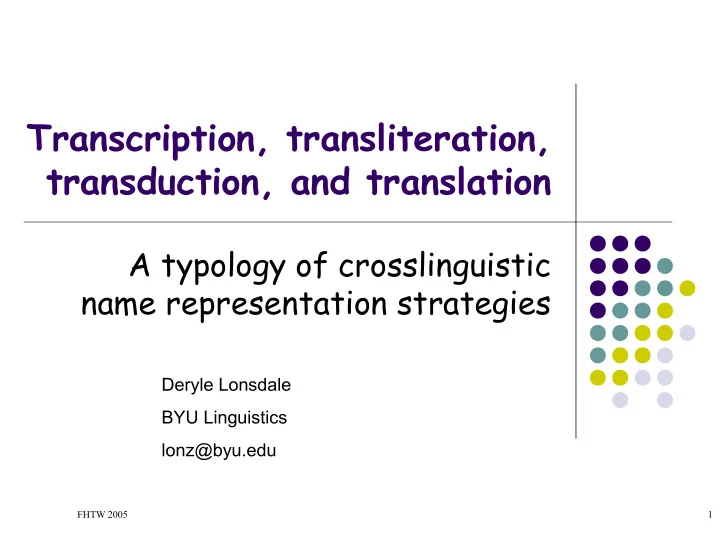

Transcription, transliteration, transduction, and translation A typology of crosslinguistic name representation strategies Deryle Lonsdale BYU Linguistics lonz@byu.edu FHTW 2005 1
The crossroads Many NLP applications treat personal names (CL)IR of text (MUC, TREC, TIPSTER) (CL)IR of spoken documents (TDT) Information extraction (ACE) i18n, l10n OCR/digitization Semantic Web annotation Homeland security and DoD (Aladdin, REFLEX) and, of course, Family history research (PAF, TMG, etc.) 2 FHTW 2005
The problem Storing and accessing proper nouns crosslinguistically b ʊʃ ブッシュ 부시 bu شوب ? S µáõ 布什 ß Буш Μπους Bush 3 FHTW 2005
What we won’t address... Other types of proper nouns (organizations, countries, etc.) Position and title modifiers Selection and ordering of name components (surname, patronymics, etc.) Nicknames and hypocoristics Morphological variants (case, honorifics) Coreference, reduced forms, subsequent mentions 4 FHTW 2005
Issues Scope: some 6,000 languages Various types of writing systems Conventions: culturally/linguistically set Crosslinguistic: migrations, minorities Diachrony: spelling changes over time Innovation: names are continually invented Borrowings: names cross barriers 5 FHTW 2005
Writing systems Alphabetic: (roughly) one symbol / sound Roman (Bush), Armenian ( µáõß) , Georgian, etc. Syllabic: (usually) one symbol / syllable Hiragana, Katakana ( ブッシュ ), Cherokee, etc. Abugidic (alphasyllabic): CV* Devanagari ( buS) , Inuktitut, Lao, Thai, Tibetan, etc. Logographic: (roughly) one symbol / word Hieroglyphs, Hieratic, Cuneiform, Hanzi ( 布什 ), etc. 6 FHTW 2005
Special cases Hangul underlyingly alphabetic sounds are arranged compositionally into syllabic symbols ( 부시 ) Abjads alphabetic, but without (some/all) vocalization e.g. Arabic, Hebrew, Persian ( شوب ) 7 FHTW 2005
Normalization Direction left-right vs. right-left horizontal vs. vertical boustrophedonic Case DeVon vs. Devon Vocalization McConnell, St. John Diacritics Étienne vs. Etienne Punctuation Abbreviations 8 FHTW 2005
Related computational aspects Character sets, fonts, glyphs Input/output (keyboard, display) Collation (ordering, alphabetization) 9 FHTW 2005
A few mapping strategies Don’t bother: lexical lookup Transcoding Transcription Transliteration Transduction Translation 10 FHTW 2005
Lexical lookup Rote, literal access (e.g. hash tables) Unending, expensive lexicon management task Some automation possible (bitext, text mining) Bush 布殊 Some large-scale commercial undertakings Hundreds of millions of names and variants, primarily European Similar efforts exist for CJK conversion via lookup 11 FHTW 2005
Transcoding Rote (mostly) character-by-character symbol conversion (e.g. Unix recode) x44 x61 x6e xee xb3 xdd Even codes within a language vary 布什 (Mainland China) 布希 (Taiwan) 布殊 (Hong Kong) Osama bin Laden: 10 Hanzi variants Unicode helps, but does not solve the problems 12 FHTW 2005
Transcription Conversion: (spoken) words script SAMPA (ASCII) International Phonetic Alphabet (linguistics) Bush b ʊʃ Usually spoken language = transcribed language Sometimes as a strategy for crosslinguistic textual conversion Variation is a problem: whose dialectal/idiolectal pronunciation should be used? 13 FHTW 2005
Transliteration Rewrite symbols of source language in target alphabet Bush Буш Source/target sounds don’t always align 32 English spellings for Muammar Gaddafi 6 Arabic spellings for Clinton Sensitive to properties of target language e.g. Yuschenko vs. Iouchtchenko Romanization chaos: scores of schemes 14 FHTW 2005
Transduction Mapping variable correspondences (transcription, transliteration), often (probabilistic) rule-based Implemented via algorithmic finite-state automata e.g. Soundex (Russell, American, Daitch-Mokotoff), others Bush buS Alternate spellings based American soundex Daitch-Mokotoff soundex upon easily confused alternatives alternatives letters Bcller, Bebler, Beiler, Beler, Beller Aueler, Beler, Fbeler, Belber, Belier, Bellcr, Feler, Peler, Pfeler, Bellen, Bellor, Boller, Ppheler, Veler, Weler Bcbler, and 152 others... 15 FHTW 2005
Problems with Soundex Long names: Sivaramakrishnarao, Sivaramakrishnan, Sivaramarao Implausible collapses Anglocentric Alphabetic-based Not very efficient distributionally 16 FHTW 2005
Translation Most widely used when logographic system is used Names are rendered non-literally, non-phonemically to/from logograph (sequence) Great Salt Lake 大鹽湖 Creative, most opaque of mapping schemes 17 FHTW 2005
Common techniques used Machine learning Statistical/stochastic approaches (e.g. n-grams) Entropy/noisy channel approaches Rule-based transformational approaches String matching algorithms Levenshtein edit distance (similarity measure) Dynamic programming techniques Speech processing (recognition, TTS) Bitext mining, alignment metrics, indexing 18 FHTW 2005
What’s the best method? One of schemes listed previously All approaches are information-losing propositions Hybrid approaches combining several of these Pipeline results Poll different engines for optimal results How to generalize beyond a handful of languages? 19 FHTW 2005
The direct model Pairwise conversion between specific languages Potentially n x m components Not all pairs will likely be needed, though Developer expertise a problem 20 FHTW 2005
The pivot model Neutral “interlingua” or pivot n + m components What could serve as the pivot? Some small-scale examples exist ISCII for Dravidian-script (South Asian) languages 21 FHTW 2005
Pivot desiderata Neutral representation scheme Should address all possible writing systems Should assure as lossless a conversion as possible Should encode all necessary information Principled enough to allow algorithmic implementation Generative capability necessary Is it even possible to have only one pivot? 22 FHTW 2005
Pivot = alphabet? English? Consistency: very bad sound/symbol mapping Anglocentricity IPA? Transparency: difficult for non-linguists Comprehensive, but not totally adequate Logographs would be problematic 23 FHTW 2005
Pivot = syllabic? Not as intuitive to alphabet users Syllable definition is still debated in some languages Ambisyllabicity Mary, Brigham, Deryle 24 FHTW 2005
Pivot = logographic? Need to invent character (sequences) Meaning is not always obvious Impracticality: complexity of representation, script 25 FHTW 2005
An articulated pivot approach More than one “pivot”, feed into each other n + m + p components Allows grouping of typologically similar languages Intra-pivot links could represent current research results (most commonly used languages) 26 FHTW 2005
Conclusions Rich area for current research The issues are daunting Various approaches are being implemented MT has tackled some of the same problems A principled solution might involve some type of articulated pivot Open annotation environment, sharable resources, algorithm libraries Genealogists can contribute 27 FHTW 2005
Recommend
More recommend